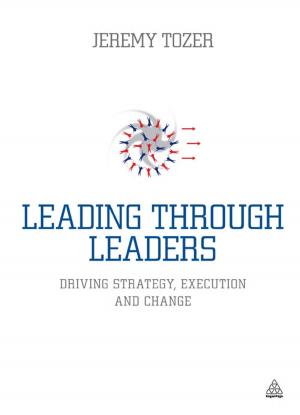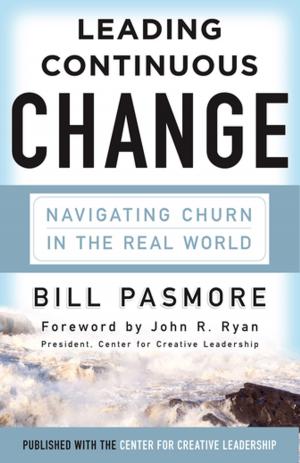The Three Pillar Model for Business Decisions: Strategy, Law and Ethics
Business & Finance, Management & Leadership, Decision Making & Problem Solving, Management| Author: | George Siedel | ISBN: | 9780997056617 |
| Publisher: | Van Rye Publishing, LLC | Publication: | January 16, 2017 |
| Imprint: | Smashwords Edition | Language: | English |
| Author: | George Siedel |
| ISBN: | 9780997056617 |
| Publisher: | Van Rye Publishing, LLC |
| Publication: | January 16, 2017 |
| Imprint: | Smashwords Edition |
| Language: | English |
Your friend decides to order a pizza. President Obama decides to authorize the mission that leads to the death of Osama bin Laden. You decide that your business should launch a new product. What do these decisions have in common? They all require using the Three Pillar model of decision making. Our personal, leadership, and business decisions are based on a Law Pillar, a Strategy Pillar, and an Ethics Pillar.
The Three Pillar model originated in a leadership course that every Harvard MBA student takes before graduation. The Harvard course is based on three lenses of decision making: economics, law, and ethics. The Three Pillar model expands these lenses by replacing “economics” with “strategy.” With this change, the model becomes a powerful tool for personal and leadership decisions, as well as for business decisions.
This book takes you through four steps that enable you to use the Three Pillar model for business decisions:
Step One: Become a legally savvy leader. This does not require memorization of legal rules. Instead, you should understand how the law works in practice. Various surveys have identified the key legal areas that every business leader should understand: product liability, employment law, government regulation, intellectual property, contracts, and dispute resolution. This book provides briefings on each area and shows how they impact your key stakeholders: customers, employees, government, and investors.
Step Two: Become an effective risk manager. After your briefings on the law, you are now ready to focus on the Law Pillar. The Law Pillar emphasizes risk management. This book explains how to manage the legal risks that constitute the main threat to your business success. For example, the chapter on product liability will describe how to make strategic new product decisions, how to isolate product risks by creating subsidiaries, and how to design new products to minimize the risk of being sued for selling a defective product.
Step Three: Align the Strategy Pillar with the Law Pillar to create value. Many leaders think that there is an inherent tension between the Strategy Pillar, with its value creation orientation, and the Law Pillar, with its risk management orientation. This book explains how you can overcome this tension and align the two pillars by focusing on the interests of each of your stakeholders. For example, by focusing on customer interests, a process designed to prevent product liability can be transformed into a powerful product development tool.
Step Four: Develop an ethical organization. Understanding the Ethics Pillar of decision making enables you to play a leadership role in developing compliance and values standards for your organization. This role requires that you “walk the talk” by using a principled process for making ethical decisions. By combining the Ethics Pillar with the Law Pillar and the Strategy Pillar, you can become a responsible corporate citizen while at the same time creating value for your shareholders and other stakeholders.
Once you master the Three Pillar model for business decisions, you can easily apply the model to personal decisions and to leadership in any organization.
Your friend decides to order a pizza. President Obama decides to authorize the mission that leads to the death of Osama bin Laden. You decide that your business should launch a new product. What do these decisions have in common? They all require using the Three Pillar model of decision making. Our personal, leadership, and business decisions are based on a Law Pillar, a Strategy Pillar, and an Ethics Pillar.
The Three Pillar model originated in a leadership course that every Harvard MBA student takes before graduation. The Harvard course is based on three lenses of decision making: economics, law, and ethics. The Three Pillar model expands these lenses by replacing “economics” with “strategy.” With this change, the model becomes a powerful tool for personal and leadership decisions, as well as for business decisions.
This book takes you through four steps that enable you to use the Three Pillar model for business decisions:
Step One: Become a legally savvy leader. This does not require memorization of legal rules. Instead, you should understand how the law works in practice. Various surveys have identified the key legal areas that every business leader should understand: product liability, employment law, government regulation, intellectual property, contracts, and dispute resolution. This book provides briefings on each area and shows how they impact your key stakeholders: customers, employees, government, and investors.
Step Two: Become an effective risk manager. After your briefings on the law, you are now ready to focus on the Law Pillar. The Law Pillar emphasizes risk management. This book explains how to manage the legal risks that constitute the main threat to your business success. For example, the chapter on product liability will describe how to make strategic new product decisions, how to isolate product risks by creating subsidiaries, and how to design new products to minimize the risk of being sued for selling a defective product.
Step Three: Align the Strategy Pillar with the Law Pillar to create value. Many leaders think that there is an inherent tension between the Strategy Pillar, with its value creation orientation, and the Law Pillar, with its risk management orientation. This book explains how you can overcome this tension and align the two pillars by focusing on the interests of each of your stakeholders. For example, by focusing on customer interests, a process designed to prevent product liability can be transformed into a powerful product development tool.
Step Four: Develop an ethical organization. Understanding the Ethics Pillar of decision making enables you to play a leadership role in developing compliance and values standards for your organization. This role requires that you “walk the talk” by using a principled process for making ethical decisions. By combining the Ethics Pillar with the Law Pillar and the Strategy Pillar, you can become a responsible corporate citizen while at the same time creating value for your shareholders and other stakeholders.
Once you master the Three Pillar model for business decisions, you can easily apply the model to personal decisions and to leadership in any organization.















